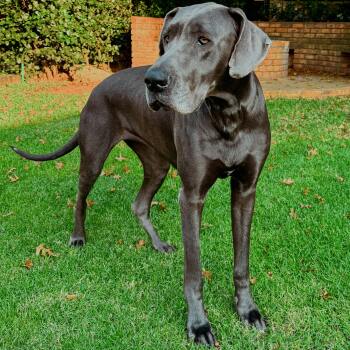Great Danes

A gentle heart in a giant frame.
Big dog, bigger heart. The Great Dane is one of the most impressive dogs you’ll ever meet—both in size and in spirit. Known lovingly as the “Gentle Giant,” this breed brings together confidence, kindness, and just the right amount of goofiness. They’re calm, friendly, and surprisingly sensitive, making them a favorite for families and dog lovers alike.
What Makes Them So Lovable:
- Sweet-natured and loyal: Danes are famously affectionate and often form close bonds with their people, especially kids.
- Low-key indoors: Despite their size, they’re content lounging around the house (preferably with their head in your lap).
- Natural protectors: While not aggressive, their size and deep bark make them excellent deterrents to uninvited guests.
- Playful companions: Their athleticism and love of play make for some fun (and often goofy) moments.
A Few Challenges to Know:
- Not a small-space pup: These dogs need room—both to stretch out and to move around comfortably.
- Short bursts of zoomies: Young Danes can be surprisingly rambunctious and may unintentionally knock things (or people!) over.
- Drool and gas: It’s all part of the charm, right?
- Sensitive souls: Without regular interaction, they can develop separation anxiety or nervousness toward strangers.
History in Brief
The Great Dane’s lineage stretches back over 400 years to Germany, where they were bred to hunt wild boar and guard estates. With ancestry linked to the Irish Wolfhound and Old English Mastiff, these dogs were built for power and presence. Thankfully, today’s Great Dane is more likely to be found curled up on the couch than chasing down game—but their majestic appearance and regal bearing remain.
Lifespan and Health Outlook
With an average lifespan of 7–10 years, Great Danes are unfortunately considered a “short-lived” breed, though advances in veterinary care are helping many live longer, healthier lives. Regular wellness checks, early screenings, and proper nutrition are key to keeping your Dane feeling their best.
Genetic Health Concerns in Great Danes
- Bloat (Gastric Dilatation and Volvulus)— This is a medical emergency that occurs when the stomach fills with gas and twists. It can become life-threatening within minutes. Symptoms include an enlarged abdomen, unproductive retching, or pacing. Ask us about preventive surgery options if you own a Great Dane.
- Dilated Cardiomyopathy (DCM)— DCM is a serious condition where the heart becomes weak and enlarged, making it difficult to pump blood. Annual heart screenings with echocardiograms or ECGs can help catch early signs.
- Bone & Joint Concerns— Due to their rapid growth and size, Danes are prone to joint conditions such as:
- Hip & elbow dysplasia
- Osteochondritis dissecans (OCD)— where cartilage separates from bone
- Panosteitis (growing pains)— causing limping that shifts from leg to leg
Maintaining a healthy weight and feeding a large-breed puppy formula helps reduce risks.
- Wobbler Syndrome— This neurological condition affects the neck and spine, leading to an unsteady gait, stumbling, or weakness. Treatments range from medications to surgery depending on severity.
- Addison’s Disease— This hormonal condition results from adrenal insufficiency. Signs like lethargy, vomiting, and muscle weakness may be subtle. Bloodwork helps us diagnose and manage it with medication.
- Bleeding Disorders— Conditions like hemolytic anemia and thrombocytopenia can cause the body to attack its own blood cells. Symptoms may include bruising, fatigue, and pale gums. Testing before surgery is important for Danes.
- Hypothyroidism— An underactive thyroid can lead to weight gain, skin issues, and mood changes. A blood test confirms it, and it’s easily managed with daily medication.
- Skin Issues & Allergies— From mange (caused by Demodex mites) to chronic allergies, Great Danes may experience itchy skin, frequent ear infections, or red, inflamed paws. Don’t worry—we offer many options to keep your pup comfortable.
- Dental Development Issues— Some Danes have unique dental quirks like missing teeth (oligodontia) or misaligned bites (malocclusion). Early exams help us intervene before problems arise—yes, even with doggy braces if needed!
- Eye Concerns— Regular exams are important to catch conditions like cataracts, entropion, and other hereditary vision issues early. Your Dane’s beautiful gaze deserves to stay clear and pain-free.
Ready to Learn More? We’re Here to Help!


